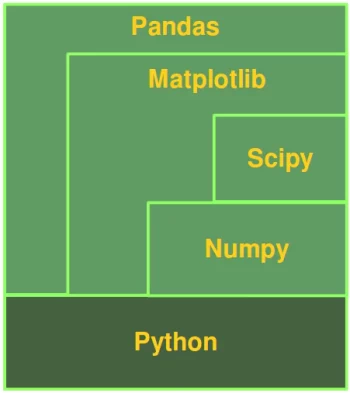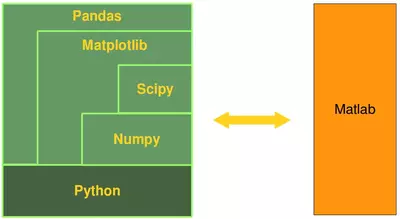Numerical Programming with Python
By Bernd Klein. Last modified: 01 Feb 2022.
Numerical Programming Definition
The term "Numerical Computing" - a.k.a. numerical computing or scientific computing - can be misleading. One can think about it as "having to do with numbers" as opposed to algorithms dealing with texts for example. If you think of Google and the way it provides links to websites for your search inquiries, you may think about the underlying algorithm as a text based one. Yet, the core of the Google search engine is numerical. To perform the PageRank algorithm Google executes the world's largest matrix computation.
Numerical Computing defines an area of computer science and mathematics dealing with algorithms for numerical approximations of problems from mathematical or numerical analysis, in other words: Algorithms solving problems involving continuous variables. Numerical analysis is used to solve science and engineering problems.
Live Python training
See our Python training courses
Data Science and Data Analysis
This tutorial can be used as an online course on Numerical Python as it is needed by Data Scientists and Data Analysts.
Data science is an interdisciplinary subject which includes for example statistics and computer science, especially programming and problem solving skills. Data Science includes everything which is necessary to create and prepare data, to manipulate, filter and clense data and to analyse data. Data can be both structured and unstructured. We could also say Data Science includes all the techniques needed to extract and gain information and insight from data.
Data Science is an umpbrella term which incorporates data analysis, statistics, machine learning and other related scientific fields in order to understand and analyze data.
Another term occuring quite often in this context is "Big Data". Big Data is for sure one of the most often used buzzwords in the software-related marketing world. Marketing managers have found out that using this term can boost the sales of their products, regardless of the fact if they are really dealing with big data or not. The term is often used in fuzzy ways.
Big data is data which is too large and complex, so that it is hard for data-processing application software to deal with them. The problems include capturing and collecting data, data storage, search the data, visualization of the data, querying, and so on.
The following concepts are associated with big data:
- volume:
the sheer amount of data, whether it will be giga-, tera-, peta- or exabytes - velocity:
the speed of arrival and processing of data - veracity:
uncertainty or imprecision of data - variety:
the many sources and types of data both structured and unstructured
The big question is how useful Python is for these purposes. If we would only use Python without any special modules, this language could only poorly perform on the previously mentioned tasks. We will describe the necessary tools in the following chapter.
Connections between Python, Numpy, Matplotlib, Scipy and Pandas

Python is a general-purpose language and as such it can and it is widely used by system administrators for operating system administration, by web developpers as a tool to create dynamic websites and by linguists for natural language processing tasks. Being a truely general-purpose language, Python can of course - without using any special numerical modules - be used to solve numerical problems as well. So far so good, but the crux of the matter is the execution speed.
Pure Python without any numerical modules couldn't be used for numerical tasks Matlab, R and other languages are designed for. If it comes to computational problem solving, it is of greatest importance to consider the performance of algorithms, both concerning speed and data usage. If we use Python in combination with its modules NumPy, SciPy, Matplotlib and Pandas, it belongs to the top numerical programming languages. It is as efficient - if not even more efficient - than Matlab or R.
Numpy is a module which provides the basic data structures, implementing multi-dimensional arrays and matrices. Besides that the module supplies the necessary functionalities to create and manipulate these data structures.
SciPy is based on top of Numpy, i.e. it uses the data structures provided by NumPy. It extends the capabilities of NumPy with further useful functions for minimization, regression, Fourier-transformation and many others.
Matplotlib is a plotting library for the Python programming language and the numerically oriented modules like NumPy and SciPy. The youngest child in this family of modules is Pandas.
Pandas is using all of the previously mentioned modules. It's build on top of them to provide a module for the Python language, which is also capable of data manipulation and analysis. The special focus of Pandas consists in offering data structures and operations for manipulating numerical tables and time series. The name is derived from the term "panel data". Pandas is well suited for working with tabular data as it is known from spread sheet programming like Excel.
Python, An Alternative to Matlab
Python is becoming more and more the main programming language for data scientists. Yet, there are still many scientists and engineers in the scientific and engineering world that use R and MATLAB to solve their data analysis and data science problems. It's a question troubling lots of people, which language they should choose:
The functionality of R was developed with statisticians in mind, whereas Python is a general-purpose language. Nevertheless, Python is also - in combination with its specialized modules, like Numpy, Scipy, Matplotlib, Pandas and so, - an ideal programming language for solving numerical problems. Furthermore, the community of Python is a lot larger and faster growing than the one from R.
The principal disadvantage of MATLAB against Python are the costs. Python with NumPy, SciPy, Matplotlib and Pandas is completely free, whereas MATLAB can be very expensive. "Free" means both "free" as in "free beer" and "free" as in "freedom"!
Even though MATLAB has a huge number of additional toolboxes available, Python has the advantage that it is a more modern and complete programming language. Python is continually becoming more powerful by a rapidly growing number of specialized modules.
Python in combination with Numpy, Scipy, Matplotlib and Pandas can be used as a complete replacement for MATLAB.

In this chapter
| Page | Description |
|---|---|
| 1. Introduction to NumPy | NumPy tutorial: NumPy is used for scientific computing with Python. This is an introduction for beginners with examples. |
| 2. Creating Numpy Arrays | NumPy tutorial: Creating basic array structures and manipulating arrays. Introducing shape, dimension and Slicing. One-dimensional and multi-simensional arrays. |
| 3. Numpy Data Objects, dtype | Tutorial and Introduction to data types and dtype in numpy |
| 4. Numerical Operations on Numpy Arrays | Using operators in numpy and applying them on Numpy Arrays, compared to using operators in 'pure' Python |
| 5. Numpy Arrays: Concatenating, Flattening and Adding Dimensions | NumPy: Changing the Dimensions of arrays with the functions newaxis, reshape and ravel. concatenating arrays |
| 6. Python, Random Numbers and Probability | Python, Numpy and ways to cope with probability and randomness. Introductory Tutorial. |
| 7. Weighted Probabilities | Python Tutorial on weighted random Choice and Sample. Synthetically created Sales Figures. Exercises with solutions. |
| 8. Synthetical Test Data With Python | Creating Synthetical Test and Learn Sets using random functions of Python and Numpy |
| 9. Numpy: Boolean Indexing | NumPy: Boolean Masking of Arrays |
| 10. Matrix Arithmetics under NumPy and Python | Introduction with examples into Matrix-Arithmetics with the NumPy Module |
| 11. Reading and Writing Data Files: ndarrays | Tutorial on how to read and write from and to files. |
| 12. Overview of Matplotlib | Introduction to Matplotlib for beginners as part of a complete Python tutorial. |
| 13. Formatting a plot in Matplotlib | Introduction into Matplotlib for beginners as part of a complete Python tutorial. |
| 14. Matplotlib Object Hierarchy | Introduction in the Hierarchy of Matplotlib object. |
| 15. Spines and Ticks in Matplotlib | Matplotlib Tutorial: Customizing spines and ticks |
| 16. Adding Legends and Annotations in Matplotlib | Matplotlib Tutorial: Adding legends and annotations to plots. |
| 17. Creating Subplots in Matplotlib | Matplotlib Tutorial: Subplots and their creation. |
| 18. Gridspec in Matplotlib | Matplotlib Tutorial: Introduction into Gridspecs and examples |
| 19. Histograms with Matplotlib | Python-Course: Creating Histograms with Python and Matplotlib. |
| 20. Contour Plots with Matplotlib | Matplotlib Tutorial: Introduction in Countour Plots both line based and filled contour plots. |
| 21. Image Processing in Python with Matplotlib | Image processing in Python with Matplotlib, Numpy and Scipy. Tutorial with examples. |
| 22. Image Processing Techniques with Python and Matplotlib | Tutorial on Image Processing Techniques with Python, Numpy and Matplotlib |
| 23. Creating Videos from One or More Images | In this Python course we show how to create a video from one or more images. Simply by showing the images for some seconds sequentially or suing a tiling technique. |
| 24. Moving Watermarks Video with Python | This Python tutorial explains how to create videos with moving object (visible watermarks) from one or more picture by using Numpy and Matplotlib. |
| 25. Introduction to Pandas | Tutorial with Examples on Pandas in Python |
| 26. Pandas DataFrame | Tutorial on DataFrame data type of Pandas |
| 27. Accessing and Changing values of DataFrames | Matplotlib Tutorial: replace, at, loc to change values. |
| 28. Pandas Styling | Learn Pandas DataFrame styling in this tutorial. Format, highlight, and visualize data for better presentation. Perfect for beginners and pros! |
| 29. Pandas Pivot | Introduction in the Pandas pivot function |
| 30. Pandas: groupby | Pandas Tutorial: split, apply and combine with groupby. |
| 31. Pandas Groupby Example | An extensive Pandas example using groupby to evaluate a csv data file. |
| 32. Reading and Writing Data in Pandas | Tutorial with Examples on Reading and Writing Data in Pandas |
| 33. Dealing with NaN | Dealing with NaN (Not a Number) values in Python and in Numpy |
| 34. Binning in Python and Pandas | Binning data with Python functionalities and by using Pandas binning possibilities |
| 35. Multi-level Indexing in Pandas | Continuation of the Pandas Tutorial. Introducing details of indexing, especially multi level indexing |
| 36. Data Visualization with Pandas | Visualisations with Pandas and Python |
| 37. Python Date and Time | Python, Time and Date |
| 38. Time Series in Pandas and Python | Python, Pandas and Time Series |
| 39. Expenses and income example with Pandas and Python | Expenses, income and taxes example with Pandas and Python |
| 40. Net Income Method Example with Numpy, Matplotlib and Scipy | Extensive Example with Panadas: Net Income Taxes calculations |
| 41. Estimation of Corona cases with Python and Pandas | Estimating the number of infected people, the real number i.e. known and unknown in Germany |
| 42. Linear Combinations in Python | Calculating linear combinations for finite sets of terms and constants in Python |
